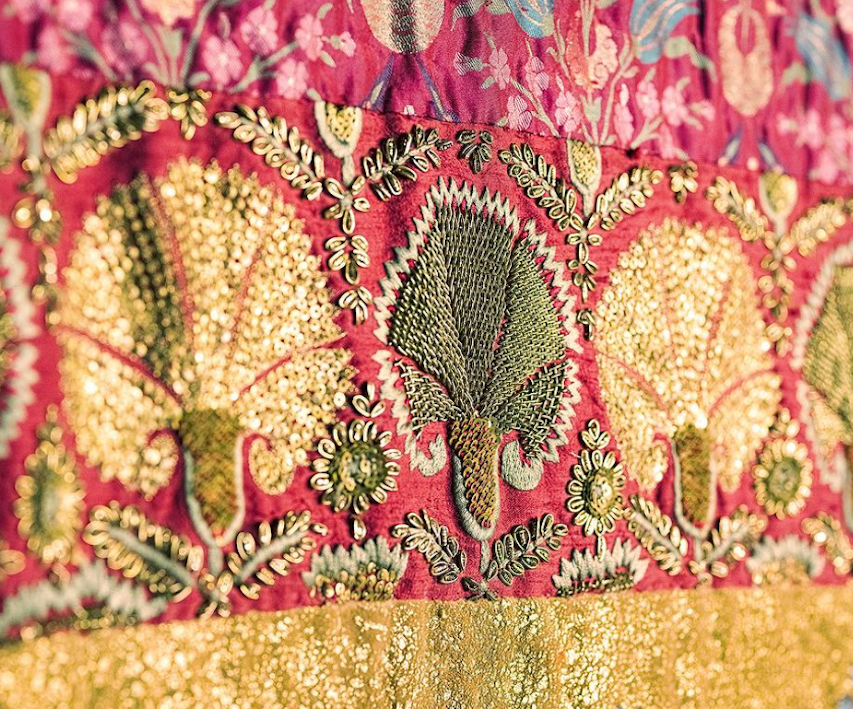
GLOBAL NOMAD: TRAVELLING TRADITIONS OF INDIAN TEXTILES
How much significance can a single quilt carry? Across cultures women have used remnant textiles to patch and sew coverings for their families - a tradition created out of thrift and necessity, that most often became a personal artistic expression of the dreams they carried while labouring over days and months to create that quilted covering.

Image: detail of Good Earth Textile Art, Quilt 1, Sindhu Ajrak. Image above: detail of Good Earth Textile Art, Quilt 1, Sarnath Brocade quilt.
Passed on within the family, the quilts not only offer comfort against the cold, but also a connection to home, to ancestry, to shared traditions. To a tangible piece of someone’s hands and heart.
Inspired by the borderless culture of quilting — a textile that not only is a canvas for storytelling, but an amalgamation of different identities and legacies. This living heritage guides our on-site installation titled, Global Nomad, a testament to India’s handcraft traditions and the way they have influenced the world. Within this space we explore the historicity and enduring value of two ancient textile crafts of printed Ajrakh and woven textiles of Kashi Benaras that have flourished for millennia along the banks of two mighty rivers, Sindhu and Ganga, uniquely Indian yet globally relevant.
The exchange of ideas particularly among early travelling communities informs our one-of-a-kind, hand-sewn, patch-worked textiles, and how the singular can enhance and enrich the collective. The reverse of each quilt is similarly patched with precision and detail, a nod to the imprints left behind by cross-cultural dialogues, often invisible yet equally vital.

Image: Good Earth Textile Art, Quilt 1, Sindhu Ajrak.
The colour of time, of the very beginning, a deep blue. Of the river Sindhu, which witnessed the birth of a civilisation and nurtured it for centuries. Of natural indigo, born from the earth, the first colour found in the world. Of the midnight sky, where a constellation of stars and the eternal chaand remain steadfast, yet ever changing.
Enlightenment in Buddhism, immortality in Islam, wish fulfilment in Vedic culture — the different symbolisms of the Tree of Life come together in Good Earth’s vocabulary as a meandering design reminiscent of Kalamkari florals, a craft that originated in the Coromandel Coast and gave the world the design legacy of Chintz.
The Tree of Life quilt has been patched with Ajrakh fabrics retrieved from our archives. The textile tradition of the ancient, highly complex craft of Ajrakh has its roots in the Indus Valley Civilisation. The world owes a debt to its inhabitants who discovered the use of cotton from the plant that grew along the banks of the river Sindhu (Indus) and created the amazing innovative technology of spinning and weaving it into cloth. They also discovered another plant Indigo Ferra Tinetoria growing alongside the cotton plant and through fermenting its leaves they discovered a dye known as Neel and the Greeks named it Indigo after the country of its origin. Indigo was used to created mud resist prints on cotton cloth over 2500 years ago and that is the genesis of Ajrakh. The tradition is unbroken and continues to flourish in Sindh and in the artisan communities of Kutch even today.
It is this history that inspired the deep natural indigo background of our quilt created by artisans in Kala Khoj — a producer co-owned initiative by 11.11 / eleven eleven. Using natural indigo extracted from the plant, they created the foundation of this hand spun, handwoven textile, highlighting it with simple tied bandhani. Mirrorwork and dabka details evoke the twinkling desert night sky, while kantha stitches create quilting patterns the traditional way. 
Image: Good Earth Textile Art, Quilt 1, Sarnath Brocade quilt.
An unbroken tradition of textile, luminous with tales from the Silk Route and beyond. Its heart lies in Banaras, on the banks of the river Ganga (Ganges), where the light at dawn is a poem. It is the soul of India, with its history of fine golden weaves from the times of Rig Veda. Its essence lies in the artisans, whose hands carry imprints of generations of skill and knowledge.
Buddhist medallions of intertwined clouds, Tibetan ceremonial robes, lush florals from Mughal art and architecture — distinct design influences come together in our archival Benarasi brocades, patched to create the Sarnath quilt. A tribute to the textile that travelled the world over.  Image: Good Earth Textile Art, Sarnath Brocade.
Image: Good Earth Textile Art, Sarnath Brocade.
In the Sarnath quilt, we celebrate the spirit of exchange and confluence, through an abundance of techniques, and fabrics: Brocade, silk, and velvet; zardozi, block printing and embroidery on gold leaf in shades of cerise, midnight blue, emerald, and jamun. All patched and quilted around a resplendent peacock, a recurring leitmotif of Kashi. Much like a jigsaw or mosaic, these individual patches tell a story of time, tradition, travel.
From the time of the Rig Veda, weaving thrived in Kashi Benaras, the oldest living city in the world; centuries later, this culture strengthened further with shimmering silk brocades (kinkhab) of the Mughal court. This legacy informs the richly layered patterns of the Sarnath quilt, an ode to our signature maximal aesthetic in the style of vintage manuscripts such as the Mughal Padshahnama, where borders within borders surround a central motif to create a world of wonder.
Find out more:
www.goodearth.in
@goodearthindia
